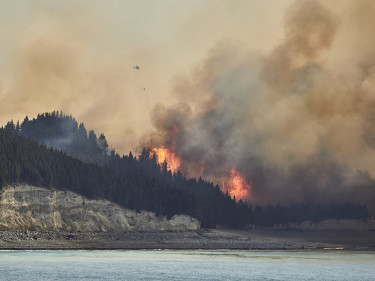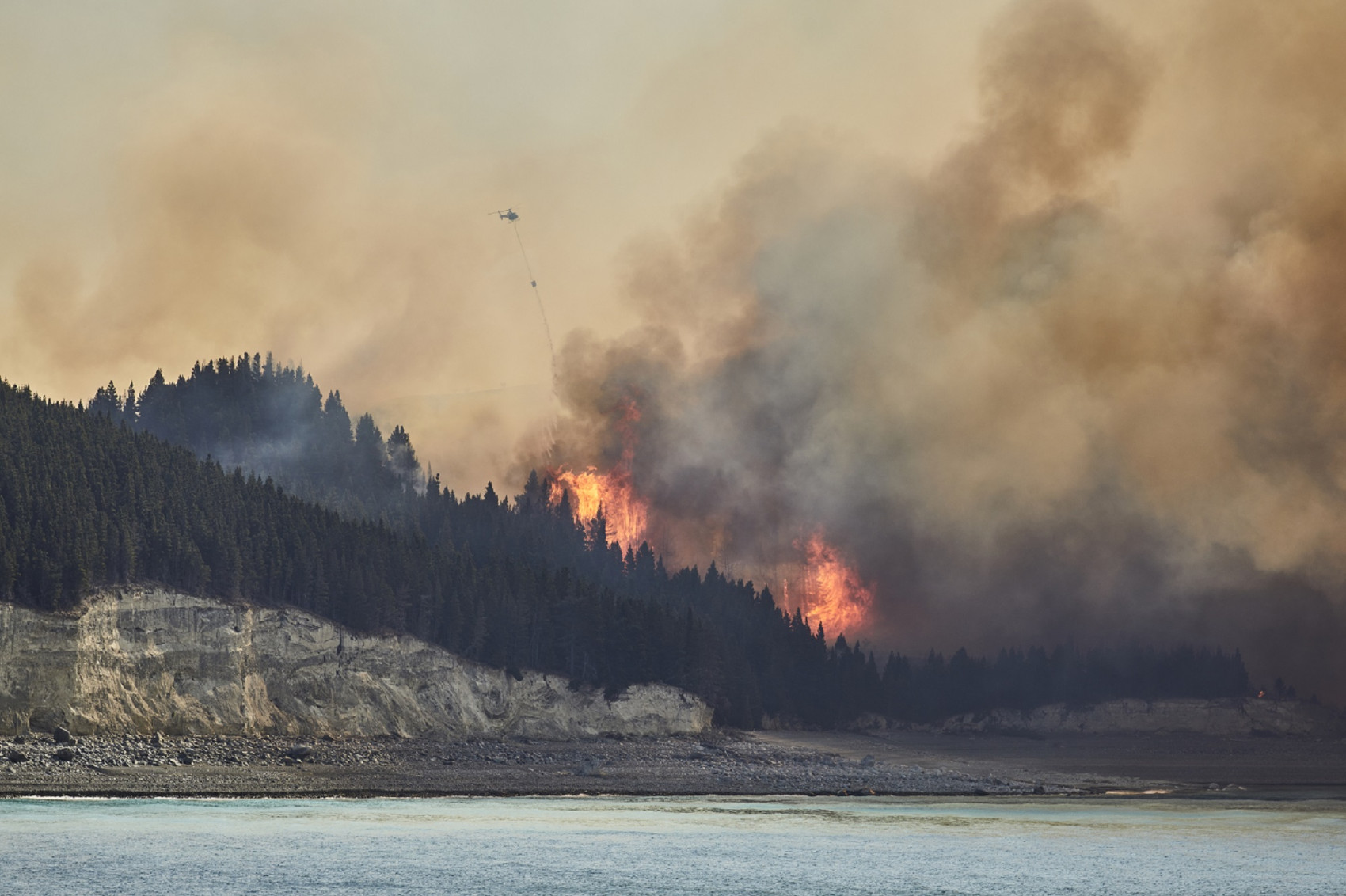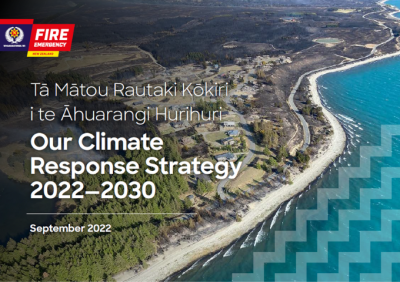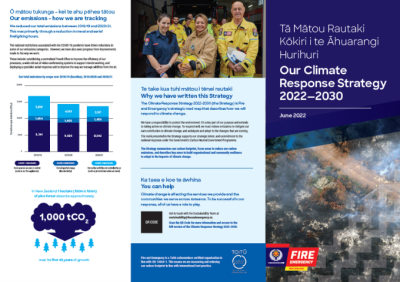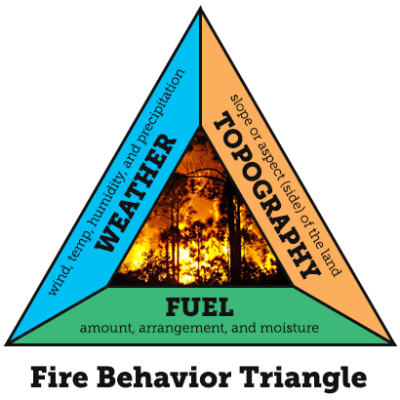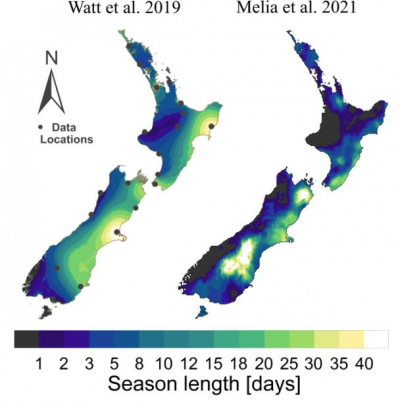Climate change has been recognised as the most complex challenge of our generation. Among the many consequences of climate change, wildfires are growing in intensity and spreading in range across Earth’s ecosystems (United Nations Environmental Programme, 2022).
The impacts of climate change are expected to affect our operations. We have already seen wildfires occurring earlier during the warmer months, and an increasing number of extreme weather events causing flooding and storm damage. These events are expected to become more common, and more damaging with rising temperatures.
Our Climate Response Strategy 2022-2030
Tā Mātou Rautaki Kōkiri i te Āhuarangi Hurihuri
At Fire and Emergency, we have a responsibility to protect the environment. It’s a key part of our purpose and extends to taking action on climate change. To respond well, we must reduce emissions to mitigate our own contribution to climate change, and anticipate and adapt to the changes that are coming.
Fire and Emergency’s Climate Response Strategy 2022-2030 is the organisation’s strategic road map that describes our focus areas to respond to climate change.
Our climate is changing
Global warming of the climate system attributed to human activities has been widely studied and evidenced. The accumulation of carbon dioxide (CO2) and other greenhouse gases in the atmosphere is driving atmospheric warming. This is having a impact on our environmental systems, and has started to impact our way of life. The last time CO2 in the atmosphere was this high was over 3 million years ago (Intergovernmental Panel on Climate Change (IPCC), 2022). Increasing air temperatures are driving other aspects of the climate, including the occurrence and severity of extreme rainfall events, droughts and the risk of wildfires. Rising sea levels will make many coastal communities and infrastructure increasingly vulnerable to floods, coastal erosion, tsunamis and other natural disasters (IPCC, 2021).
Data shows the New Zealand’s environment is changing due to the impact of climate change, and it is expected to continue to change into the future.
- Since records began (in 1909), New Zealand’s average air temperature has warmed by ~1.1°C. If global emissions remain high, temperatures are projected to increase by a further 1.0°C by 2040 and 3.0°C by 2090.
- In the last 60 years, sea levels have risen by 2.44 mm per year. If global emissions remain high, sea levels will increase by a further 0.21 m by 2040 and 0.67 m by 2090.
- The number of warm days (over 25°C) and heatwave days (three consecutive days 5°C above the monthly average) is increasing in areas across the country.
- Annual and seasonal rainfall is changing. Extreme weather events such as storms, heatwaves and heavy rainfall are likely to be more frequent and intense. Large increases in extreme rainfall are expected everywhere in the country, particularly in Northland due to a projected increase in ex-tropical cyclones.
- As the atmosphere continues to warm, the number of frost and snow days are projected to decrease, and dry days to increase for much of the North Island and for some parts of the South Island.
- Drought is predicted to increase in frequency and severity, particularly along the eastern side of the Southern Alps.
- Increased northeasterly airflows are projected in summer and stronger westerlies in winter, the latter particularly in the south of the South Island.
- Wildfire risk is predicted to increase in many areas towards the end of the century, due to higher temperatures and wind speeds, and decreased rainfall and relative humidity.
The National Climate Change Risk Assessment for Aotearoa New Zealand (Ministry for the Environment, 2020) contains more detailed information on climate-related risks for Aotearoa.
Climate risks
Despite efforts to limit the human causes of climate change, a level of change in our climate is unavoidable. Climate related hazards that have become more apparent due to the impact of climate change will continue to increase in frequency and severity, regardless of the global response to decarbonise. Future emissions will amplify this trend. Based on the science communities best understanding, the warmer climate will cause an increase in extreme fire weather days and longer fire seasons, as well as more meteorological droughts. As more energy is present in the atmosphere, extreme precipitation and flooding-related hazards will also become more frequent. Affected communities will place increasing demands on fire and emergency services assistance.
Recent research has highlighted that conditions that led to the devastating ‘Black-Summer’ fires in Australia will occur every 3-20 years in areas of the Mackenzie Country, Central Otago and Marlborough. Other regions of the country will also see increases in fire weather severity. This has implications for the potential number, frequency and impacts of future wildfires, as well as for Aotearoa New Zealand’s carbon sequestration ambitions and financial capital in planted forests (Langer et al. 2021).
Climate change and fire risk in the natural environment
Wildfires are unwanted uncontrolled fires in the natural environment. In Aotearoa, most wildfires are started by people. Climate change will not by itself cause more wildfires. Climate change will increase the risk of wildfires starting and the way in which they behave.
Weather is the factor of the fire behaviour triangle that changes most over time and space. The monitoring of fire weather helps us manage risks. Our districts monitor fire risk conditions through a network of over 300 weather stations around the country to determine the type of fire season and any restrictions needed for fire control. View up-to-date weather observations and forecasts for determining fire danger and fire behaviour.
|
In rural fire, we use the fire behaviour triangle as a conceptual tool to understand and manage fire risk. Pictured above, the fire weather behaviour triangle outlines the three main influences on wildfires. |
Research indicates that the we can expect in excess of 40 extreme fire weather days each year in some regions of the country by 2090. These are characterised by a combination of heat, wind and availability of dry fuel that make fires start easily and grow rapidly. |
Wildfire - our risk reduction strategy
Our risk reduction strategy focuses on working with rural communities, and those in the urban fringe to ensure they understand the fire risk of the environments they live and work in, and ways to manage such risk. We work with the rural sector to provide effective and common-sense fire hazard control systems. Our Districts’ Fire Plans include guidance on fire seasons and local triggers to manage fire risk from heat and spark-generating activities. We review these tools regularly, to ensure we achieve a balanced approach to any restrictions to activities.
Our risk reduction work also includes:
Research:
- improving the wildfire risks assessment tools used by many land managers and Local Authorities
- improving the understanding of fire breaking policy
- improving the capability of fire behaviour analysis
Outreach
- the national Land Management Forum with representation from partner agencies
- regional land management forums
- interagency work for management of wildfire risk nationally and locally
Things you can do - Adapting to changing fire risk
If you live, work, or play in rural settings, the activities you carry out may be limited or require a permit due to the current wildfire risk. This is one of our tools to prevent fires in the natural environment. To learn more about high fire risk activities, visit https://www.checkitsalright.nz/reduce-your-risk to find out more.
Wildfires can affect individuals, businesses and entire communities. Households, businesses and communities have a role to play in reducing their risk. From keeping your section clean of vegetation debris to having fire management plans for your farm, there are plenty of ways in which we can work together to reduce the risk of wildfires starting. Visit www.checkitsalright to find out more on how you can plan and reduce your risk in
Things we are doing - Reducing our emissions
In response to the Government’s Carbon Neutral Government Programme (CNGP), we are working to reduce our climate emissions.
For us, carbon-friendly alternatives for some of our specialised assets, such as our fleet of fire trucks, which is one of our biggest emitters of carbon, and our tools and equipment, do not exist yet or are cost prohibitive for New Zealand to invest in, in the short-medium term.
Our Emissions Reduction Plan is based on our Climate Response Strategy 2022–2030, which outlines how we will reduce our climate impact through practical mitigations.
References and further information
We all have a role to play in mitigating and adapting to climate change. The following websites contain information, research and policy documents that give shape to climate change action in Aotearoa, with particular focus on fire risk in the natural environment.
Policy
Ministry for the Environment
- National Climate Change Risk Assessment (https://environment.govt.nz/what-government-is-doing/areas-of-work/climate-change/adapting-to-climate-change/first-national-climate-change-risk-assessment-for-new-zealand/)
- Transitioning to a low-emissions and climate-resilient future: emissions reduction plan discussion document (https://environment.govt.nz/publications/emissions-reduction-plan-discussion-document/)
- Adaptation preparedness: 2020/21 baseline. A summary of reporting organisation responses to the first information request under the Climate Change Response Act 2002 (https://environment.govt.nz/publications/adaptation-preparedness-202021-baseline/)
- New Zealand’s Environmental Reporting Series: Our atmosphere and climate 2020. (https://environment.govt.nz/assets/Publications/Files/our-atmosphere-and-climate-2020.pdf)
Climate Change Commission
- Ināia tonu nei: a low emissions future for Aotearoa (https://www.climatecommission.govt.nz/our-work/advice-to-government-topic/inaia-tonu-nei-a-low-emissions-future-for-aotearoa/)
Research
Intergovernmental Panel on Climate Change:
- Sixth Assessment Report (AR6) (Sixth Assessment Report — IPCC)
- Sixth Assessment Report, Climate Change 2022: Impacts, Adaptation and Vulnerability (including Chapter 11: Australasia)
- Climate Change 2021: The Physical Science Basis. Contribution of Working Group I to the Sixth Assessment Report of the Intergovernmental Panel on Climate Change (https://www.ipcc.ch/report/sixth-assessment-report-working-group-i)
United Nations Environmental Programme
- Spreading like Wildfire: The Rising Threat of Extraordinary Landscape Fires (Spreading like Wildfire: The Rising Threat of Extraordinary Landscape Fires | UNEP - UN Environment Programme)
SCION
- Langer et al. (2021), Adapting and mitigating wildfire risk due to climate change: extending knowledge and best practice. Scion Client Report No. 36230991.
- Extreme Wildfire research programme (Rural Fire Research - Current research programmes)
- Scion Rural Fire Research Update 9 (2011), Future Fire Danger (48389-FutureFireDanger.pdf (ruralfireresearch.co.nz))
National Institute of Weather and Atmosphere (NIWA)
- Our Future Climate New Zealand’ interactive webpages (Our Future Climate New Zealand (niwa.co.nz))
Information
Royal Society Te Apārangi,
Climate Change and New Zealand (Climate change and New Zealand (royalsociety.org.nz))
Previous research on changing wildfire risk
Ministry for Primary Industries (MPI)
- Improved Estimates of the Effect of Climate Change on NZ Fire Danger (2011) (Improved estimates of the effect of climate change on NZ fire danger (mpi.govt.nz)













